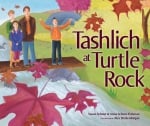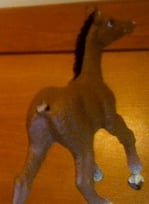When I named my blog “homeshuling”, my intention wasn’t to imply that synagogue isn’t important or can’t be meaningful. My goal was simply to show that Jewish life in the home is important and can be incredibly meaningful – sometimes even more so than what takes place within the walls of an institution. I’m not sure if I’ve succeeded, but there’s a new children’s book that has made this point brilliantly. So much so, that I almost wish the authors’ home were my shul.
 Tashlich at Turtle Rock, a new book from Kar-Ben Publishers*, written by Rabbi Susan Schnur and her daughter Anna Schnur-Fishman, tells the story of one family’s creative and intimate twist on the ceremony of Tashlich. Traditionally, on the first day of Rosh Hashanah, Jews throw bread crumbs in a body of water to represent casting off their sins from the past year. Sometimes this looks like a quick tromp to a fountain, and sometimes it’s a community migration to a stream, lake or ocean. In this story, young Annie, the narrator, leads her family into the woods for a four-part journey, using elements of the natural world to help them reflect on the past year and plan for the future.
Tashlich at Turtle Rock, a new book from Kar-Ben Publishers*, written by Rabbi Susan Schnur and her daughter Anna Schnur-Fishman, tells the story of one family’s creative and intimate twist on the ceremony of Tashlich. Traditionally, on the first day of Rosh Hashanah, Jews throw bread crumbs in a body of water to represent casting off their sins from the past year. Sometimes this looks like a quick tromp to a fountain, and sometimes it’s a community migration to a stream, lake or ocean. In this story, young Annie, the narrator, leads her family into the woods for a four-part journey, using elements of the natural world to help them reflect on the past year and plan for the future.
At one stop, the parents and children scratch words or pictures of something they want to remember from the past year into a large rock. Annie draws a bike. “This year I learned to ride a two wheeler,” she tells her family. “Hooray!”
At another stop, they search for an item that represents something they want to throw away. “Dad holds up an acorn cap that looks like a tiny mouth. ‘I want to throw away saying bad things about people,’ he says.”
At the end of the walk, each member of the family shares a promise for the upcoming year, sealing the promise with a wet footprint on a large rock.
There’s so much I love about this book. I love how fun it makes Tashlich sound. I love how much meaningful family conversation is generated by their rituals. I loved how they all say “Amen” as an exclamation point after each stop. I love how the natural world is so integral to their practice. I especially love that it’s true story.
I spent a long (and I do mean long) time on the phone with Susan Schnur, who wrote the book with her daughter, Anne (little Annie, all grown up.) From that conversation I discovered something that I love most of all, something I hadn’t even noticed in my first reading. I love that the child leads the entire ritual.
“My interest is empowering children,” Susan explained. “I say that Lillith Magazine (where she works as an editor) is my paper pulpit, but even when I had a shul, my real synagogue has always been my family. There is so much home-based ritual in Judaism, and children can be so creative. I’ve always wanted to enfranchise them.”
Susan credits her children with making her family’s ritual life so creative. But in talking with her, I was inspired by the many seeds she sowed to grow this creativity. “When it snows on chanuka, we have a family tradition to do Chanukah outside that night. Sometimes we would eat snow…..We tried to time our goats to give birth on Passover, and some years we would go out on seder night with a lantern and see them give birth….Instead of shlugging kapparos, we would pick up a chicken and whisper our mistakes in its ear.” Can you see why I’m just a tiny bit envious of this family?
Some people have criticized the book for including writing on Rosh Hashanah (scratching words into a rock which is temporary, so arguably not even writing, at least according to Torah law.) When I posted on the Homeshuling Facebook page that I was excited about the book, one librarian commented, “Did you ask her why she chose to have the family write on Rosh Hashanah? It unfortunately makes the book a little problematic in some settings.” I didn’t ask her, but I didn’t have to. This message of this book isn’t that other families should copy their exact ritual. It’s that families should create rituals that are meaningful, and appropriate, for them.
Not to mention, as a progressive Jew who lives in a semi-rural setting and happens to be married to a non-Jew, I’d say that there are plenty of books that are “a little problematic in some settings.” Our settings. Where we almost never see families that look like ours. I’m grateful that Kar-Ben published a book that honors Jews who do things a little differently.
I’m really not sure if this book will appeal to children. I’m going to read it to my Kindergarten class before our Taslich walk, and read it to my own children on Rosh Hashanah, and I’ll let you know how they reacted. But I’m quite sure this book will appeal to a lot of Jewish parents. It left me thinking about how to raise children who will take the lead in our family’s ritual life. And maybe, someday, write a book with me.
*Kar-Ben, which published my first book, send me a copy of Tashlich at Turtle Rock to review.

